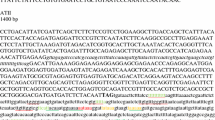Abstract
In contrast to its behavior in tobacco and tomato, the maize transposable element Ac is relatively inactive in Arabidopsis. We show here that removal of 537 by within a CpG-rich region of the Ac 5′ untranslated leader region significantly increases the excision frequency of the element in Arabidopsis. This increase did not appear to be correlated with the removal of sequences that are methylated in inactive Ac elements in maize, as these sites were not methylated in Ac elements in Arabidopsis transformants. The deletion within the 5′ untranslated leader did not increase Ac activity by increasing levels of steady-state transposase mRNA, as assayed by RNase protection experiments. Moreover, there was no correlation between the levels of steady-state transposase mRNA and Ac element activity. This suggests that post-transcriptional regulation of Ac activity occurs in Arabidopsis.
Similar content being viewed by others
References
Antequera F, Bird AP (1988) Unmethylated CpG islands associated with genes in higher plant DNA. EMBO J 7:2295–2299
Bancroft I, Bhatt AM, Sjodin C, Scofield S, Jones JDG, Dean C (1992) Development of an efficient two-element transposon tagging system in Arabidopsis thaliana. Mol Gen Genet 233:449–461
Bancroft I, Jones J, Dean C (1993) Heterologous transposon tagging of the DRL1 locus in Arabidopsis. Plant Cell 5:631–638
Bancroft I, Dean C (1993) Factors affecting the excision frequency of the maize transposable element Ds in Arabidopsis thaliana. Mol Gen Genet 240:65–72
Bird AP (1986) CpG-islands and the function of DNA methylation. Nature 321:209–213
Chang C, Bowman JL, DeJohn AW, Lander ES, Meyerowitz EM (1988) Restriction fragment length polymorphism linkage map for Arabidopsis thaliana. Proc Natl Acad Sci USA 85:6856–6860
Chomet P, Wessler S, Dellaporta S (1987) Inactivation of the maize transposable element Activator (Ac) associated with DNA modification. EMBO J 6:295–302
Coupland G, Plum C, Chatterjee S, Post A, Starlinger P (1989) Sequences near the termini are required for transposition of the maize transposon Ac in transgenic tobacco plants. Proc Natl Acad Sci USA 86:9385–9388
Dean C, Sjödin C, Page T, Jones JDG, Lister CK (1992) Behaviour of the maize transposable element Ac in Arabidopsis thaliana. Plant J 2:69–81
Deblaere R, Bytebier B, De-Greve H, Deboeck F, Schell J, van-Montagu M, Leemans J (1985) Efficient octopine Ti plasmid-derived vectors for Agrobacterium-mediated gene transfer to plants. Nucleic Acids Res 13:4777–4788
Finnegan EJ, Taylor BH, Craig S, Dennis ES (1989) Transposable elements can be used to study cell lineages in transgenic plants. The Plant Cell 1:757–764
Finnegan EJ, Lawrence GJ, Dennis E, Ellis JG (1993) Behaviour of modified Ac elements in flax callus and regenerated plants. Plant Mol Biol 22:625–633
Figurski DH, Helinski DR (1979) Replication of an origin-containing derivative of plasmid pRK2 dependent on a plasmid function provided in trans. Proc Natl Acad Sci USA 76:1648–1652
Grevelding C, Becker D, Kunze R, von Menges A, Fantes V, Schell J, Masterson R (1992) High rates of Ac/Ds germinal transposition in Arabidopsis suitable for gene isolation by insertional mutagenesis. Proc Natl Acad Sci USA 89:6085–6089
Hehl R, Baker B (1990) Properties of the maize transposable element Activator in transgenic tobacco plants: a versatile interspecies genetic tool. The Plant Cell 2:709–721
Honma M, Baker B, Waddell CS (1993) High-frequency germinal transposition of Ds ALS in Arabidopsis. Proc Natl Acad Sci USA 90:6242–6246
Jefferson RA (1987) Assaying chimaeric genes in plants: the GUS gene fusion system. Plant Mol Biol Reporter 5:387–405
Jones JDG, Carland F, Maliga P, Dooner HK (1989) Visual detection of transposition of the maize element Activator (Ac) in tobacco seedlings. Science 244:204–207
Jones JDG, Harper L, Carland F, Ralston E, Dooner H (1991) Reversion and altered variegation of an SPT::Ac allele in tobacco. Maydica 36:329–335
Jones JDG, Shlumakov L, Carland F, English J, Scofield SR, Bishop GJ, Harrison K (1992) Effective vectors for transformation, expression of heterologous genes, and assaying transposon excision in transgenic plants. Transgenic Res 1:285–297
Keller J, Lim E, James DW Jr, Dooner HK (1992) Germinal and somatic activity of the maize element Activator (Ac) in Arabidopsis. Genetics 131:449–459
Kunze R, Starlinger P, Schwartz D (1988) DNA methylation of the maize transposable element Ac interferes with its transcription. Mol Gen Genet 214:325–327
Leutwiler LS, Hough-Evans BR, Meyerowitz EM (1984) The DNA of Arabidopsis thaliana. Mol Gen Genet 194:15–23
Matzke MA, Matzke AJM (1991) Differential inactivation and methylation of a transgene in plants by two suppressor loci containing homologous sequences. Plant Mol Biol 16:821–830
Pruitt R, Meyerowitz E (1986) Characterization of the genome of Arabidopsis thaliana. J Mol Biol 187:169–184
Schmidt R, Willmitzer L (1989) The maize autonomous element Activator (Ac) shows a minimal germinal excision frequency of 0.2%–0.5% in transgenic Arabidopsis thaliana plants. Mol Gen Genet 220:17–24
Schwartz D, Dennis E (1986) Transposase activity of the Ac controlling element is regulated by its degree of methylation. Mol Gen Genet 205:476–482
Swinburne J, Balcells L, Scofield SR, Jones JDG, Coupland G (1992) Elevated levels of Activator transposase mRNA are associated with high frequencies of Dissociation excision in Arabidopsis. The Plant Cell 4:583–595
Valvekens D, van Montagu M, van Lijsebettens M (1988) Agrobacterium tumefaciens mediated transformation of Arabidopsis thaliana root explants by using kanamycin selection. Proc Natl Acad Sci USA 85:5536–5540
Van Sluys M, Tempe J, Federoff N (1987) Studies on the introduction and mobility of the maize Activator element in Arabidopsis thaliana and Daucus carota. EMBO J 6:3881–3889
Van Sluys M, Scortecci KC, Tempe J (1993) DNA methylation associated to Ac element in Arabidopsis. Plant Physiol Biochem 31:805–813
Yoder JI, Palys J, Alpert K, Lassner M (1988) Ac transposition in transgenic tomato plants. Mol Gen Genet 213:291–296
Author information
Authors and Affiliations
Additional information
Communicated by D.M. Lonsdale
Rights and permissions
About this article
Cite this article
Lawson, E.J.R., Scofield, S.R., Sjodin, C. et al. Modification of the 5′ untranslated leader region of the maize Activator element leads to increased activity in Arabidopsis. Molec. Gen. Genet. 245, 608–615 (1994). https://doi.org/10.1007/BF00282223
Received:
Accepted:
Issue Date:
DOI: https://doi.org/10.1007/BF00282223




